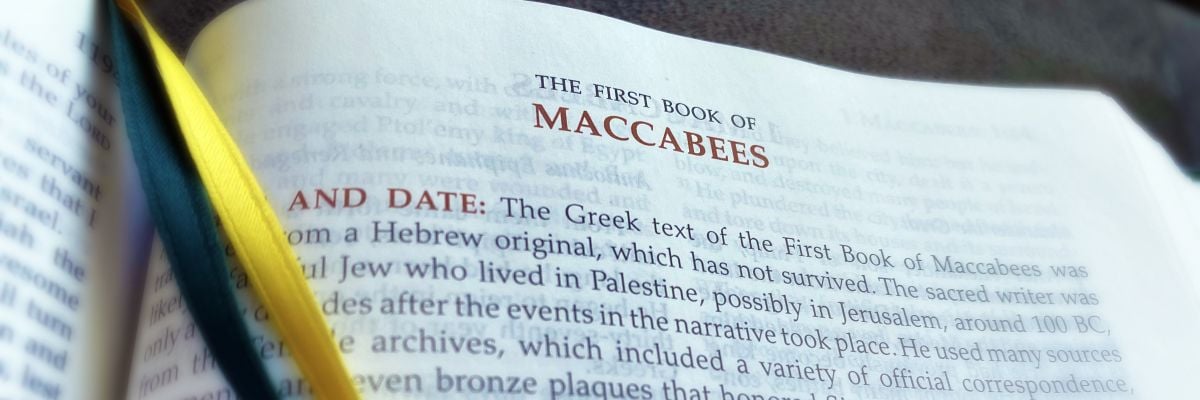
1. Why did the Catholic Church add seven books—1 and 2 Maccabees, Sirach, Wisdom, Baruch, Tobit, and Judith—to the Old Testament? John forbids this: “I warn everyone who hears the words of the prophecy of this book: if anyone adds to them, God will add to him the plagues described in this book” (Rev. 22:18).
It’s always good to start a disagreement with agreement. So before you explain the Catholic canon of the Old Testament to Protestant, agree that no one has the right to add or subtract books from the Bible. That’s about as much common ground as you may have to build on.
Quoting Rev. 22:18 against Catholics is ineffective. For one thing, the next verse could be used by the Catholics against Protestants with the same opposite force: “[A]nd if anyone takes away from the words of the book of this prophecy, God will take away his share in the tree of life and in the holy city, which are described in this book” (Rev. 22:19).
But neither verse applies to this debate. John is speaking only about the book of Revelation, not the entire Bible. None of the apostles knew the Bible. The books that comprise Scripture were not canonized until centuries after Christ. Even when that list was established in A.D. 382, the writings were not collected into a single book until after the printing press came into existence. Even Gutenberg’s Bible was published in more than one volume.
Besides, the Greek word here for “book” is more accurately translated as “scroll.” The book of Revelation likely was written on a scroll, but it would have been impossible for the entire Bible to be.
2. Since the Jews were “entrusted with the oracles of God” (Rom. 3:2), shouldn’t we have the same Old Testament canon as they do?
Though this is not a sound objection, it at least requires a detailed answer.
God’s written word was entrusted to the Jews, but he never provided them with an inspired table of contents. For that reason, there has been ample disagreement over the canon—especially among Jews.
The Old Testament took over one thousand years to compile, and the list of inspired books grew continuously as God’s word was revealed. This gradual accretion indicated that the Jewish people felt no need for a static canon but remained open to further revelation. They divided their sacred writings into three parts: the law, the prophets, and the writings (which were canonized in that order). By the time of Christ, the law—and most likely the prophets—was set in number, but the writings were not yet closed.
In Jesus’ time, the Samaritans and Sadducees accepted the law but rejected the prophets and writings. The Pharisees accepted all three. Other Jews used a Greek version (the Septuagint) that included the seven disputed books, known as the deuterocanonicals. Still other Jews used a version of the canon that is reflected in the Septuagint and included versions of the seven books in question in their original Hebrew or Aramaic.
When the Christians claimed that they had written new scriptures, Jews from a rabbinical school in Javneh met around year 80 and, among other things, discussed the canon. They did not include the New Testament nor the seven Old Testament works and portions of Daniel and Esther. This still did not settle the Pharisee canon, since not all Jews agreed with or even knew about the decision at Javneh. Rabbis continued to debate it into the second and third centuries. Even today, the Ethiopian Jews use the same Old Testament as Catholics.
If anything is certain, it is that there was no common canon among the Jews at the time of Christ.
3. But the seven deuterocanonical books were added at the Council of Trent (1546) in order to justify Catholic doctrinal inventions.
This is a myth that always comes up but is simple to answer. At the Council of Rome in 382, the Church decided upon a canon of 46 Old Testament books and 27 in the New Testament. This decision was ratified by the councils at Hippo (393), Carthage (397, 419), II Nicea (787), Florence (1442), and Trent (1546).
Further, if Catholics added the deuterocanonical books in 1546, then Martin Luther beat us to the punch: He included them in his first German translation, which he published before the Council of Trent. They can also be found in the first King James Version (1611) and in the first Bible ever printed, the Gutenberg Bible (a century before Trent). In fact, these books were included in almost every Bible until the Edinburgh Committee of the British Foreign Bible Society excised them in 1825. Until then, they had been included at least in an appendix of Protestant Bibles. It is historically demonstrable that Catholics did not add the books, Protestants took them out.
Luther had a tendency to grade the Bible according to his preferences. In his writings on the New Testament, he noted that the books of Hebrews, James, Jude, and Revelation were inferior to the rest, and they followed “the certain, main books of the New Testament.” In 1519, this same attitude fueled his debate against Johannes Eck on the topic of purgatory. Luther undermined Eck’s proof text of 2 Maccabees 12 by devaluing the deuterocanonical books as a whole. He argued that the New Testament authors had never quoted from the seven books, so they were in a different class than the rest of the Bible.
4. Well, if the New Testament never quotes from these seven books, doesn’t that indicate that they were not considered to be inspired?
Following this reasoning, we’d have to throw out the eight other Old Testament books—such as the Song of Songs—that are also not quoted in the New Testament. If we’re not willing to do that, we have to agree that the absence of a quote in the New Testament does not suggest that a book is not inspired.
Though there are no quotes, the New Testament does make numerous allusions to the deuterocanonical books. For one strong example, examine Hebrews 11:35: “Women received their dead by resurrection. Some were tortured, refusing to accept release that they might rise again to a better life.” Nowhere in the Protestant Old Testament can this story be found. One must look to a Catholic Bible to read the story in 2 Maccabees 7.
5. But the book of Judith says that Nebuchadnezzar was king of the Assyrians, when he was really king of the Babylonians. If a book has errors, it can’t be inspired.
In reading Scripture, it is imperative that we understand the genre of the work. Is it a historical passage? An apocalyptic one? A parable? A proverb? Knowing this influences how the book should be read. When Jesus says that the mustard seed is the smallest of seeds (Matt.13:32), he is not providing a treatise on botany. After all, there are seeds smaller than the mustard seed. When Jesus spoke in parables, the people understood that he was telling a story, and they did not expect it to conform to historical or scientific precision.
The same goes with the book of Judith. “Judith” means “lady Jew,” and she personifies the nation of Israel, as “Nebuchadnezzar, king of the Assyrians” personifies the enemies of the nation. The Jews of the time were aware that Nebuchadnezzar was not the king of the Assyrians but that the Babylonians and Assyrians were two of the nation’s worst foes joined into one by the author of Judith for the sake of parable.
6. Which translation did the first Christians use?
Early Christians read the Greek translation of the Old Testament, the Septuagint. It included the seven deuterocanonical books. For this reason, the Protestant historian J.N.D. Kelly writes, “It should be observed that the Old Testament thus admitted as authoritative in the Church was somewhat bulkier and more comprehensive [than the Protestant Bible]. . . . It always included, though with varying degrees of recognition, the so-called apocrypha or deuterocanonical books.” The authors of the New Testament quoted freely from the Septuagint—over 300 times.
7. Didn’t Jerome and Augustine disagree about the deuterocanonical books?
Yes, as did other early Christians. Numerous Church Fathers quoted the deuterocanonical books as Scripture, while some did not.
Jerome appears to have rejected most of the deuterocanonical parts of Scripture. But he did accept portions and included all seven books in his Latin translation of Scripture, known as the Vulgate. Ultimately, he recognized that the Church alone had the authority to determine the canon.
Since there was disagreement between some Church Fathers, it became obvious that no individual could provide an infallible list of inspired books. The bottom line: “We have no other assurance that the books of Moses, the four Gospels, and the other books are the true word of God,” wrote Augustine, “but by the canon of the Catholic Church.”
Since it is unreasonable to expect every person to read all of the books of antiquity and judge for himself if they are inspired, the question boils down to whose authority is to be trusted in this matter. One must either trust a rabbinical school that rejected the New Testament 60 years after Christ established a Church, or one must trust the Church he established.
Which deserves our trust? Martin Luther makes a pertinent observation in the sixteenth chapter of his Commentary on St. John “We are obliged to yield many things to the papists [Catholics]—that they possess the Word of God which we received from them, otherwise we should have known nothing at all about it.”



